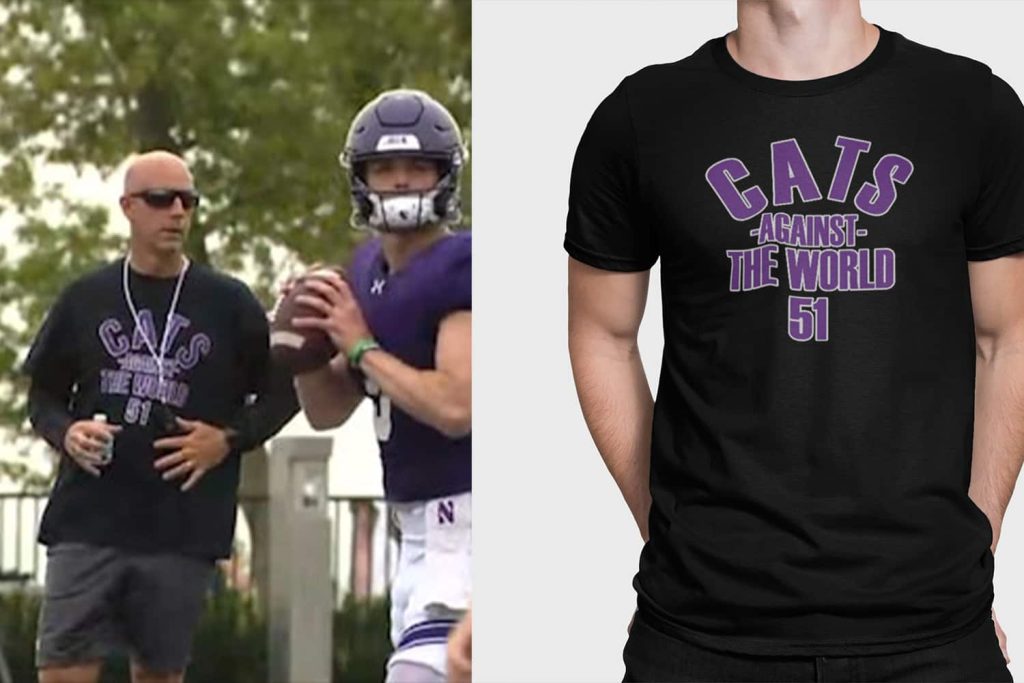News
Unraveling the Northwestern T-Shirt Scandal: The Story Behind the ‘Cats Against the World 51’ Shirt
In March 2023, Northwestern University was rocked by a hazing scandal that exposed the dark side of its football program. The scandal led to the firing of head coach Pat Fitzgerald, who was accused of condoning and participating in abusive and humiliating rituals that targeted freshmen players. Several players and staff members were also investigated for their involvement in the scandal, which tarnished the reputation of one of the most prestigious academic institutions in the country.
One of the most controversial aspects of the scandal was the T-shirts that some coaches wore at a practice session in April 2023, shortly after Fitzgerald’s dismissal. The T-shirts featured the slogan “Cats Against the World” and the number 51, which was Fitzgerald’s jersey number when he played for Northwestern in the 1990s. The staff members were seen sporting these T-shirts during the football team’s first open practice since the hazing scandal prompted Northwestern to fire Fitzgerald. The T-shirts sparked outrage and criticism from various stakeholders, who saw them as a sign of disrespect and defiance.
A clear shot of the "Cats Against the World" shirt that some Northwestern coaches/staff members were wearing at practice, with Pat Fitzgerald's old jersey #51 on them (as @Bradley_Locker first noted)@cbschicago pic.twitter.com/3fvnc0GEND
— Matt Zahn (@mattzahnsports) August 9, 2023
In this post, we will analyze the meaning and implications of the T-shirts, and explore the reactions and responses from different parties. We will argue that the T-shirts were an inappropriate and ineffective form of communication, that contradicted or undermined the efforts of Northwestern to address and prevent hazing-related issues.
The Message Behind the T-Shirts
What did the coaches who wore the T-shirts want to convey? There are several possible interpretations, but none of them are very flattering or convincing. One interpretation is that they wanted to show solidarity with Fitzgerald, who they believed was unfairly treated or scapegoated by the administration. Another interpretation is that they wanted to express defiance against the media, the public, or anyone who criticized or questioned their program. A third interpretation is that they wanted to demonstrate loyalty to their team, their school, or their tradition, regardless of the consequences or evidence.

However, none of these interpretations justify or excuse the T-shirts. The T-shirts were not a noble or courageous gesture, but a misguided and insensitive one. They ignored or dismissed the seriousness and gravity of the hazing scandal, which harmed not only the victims, but also the entire Northwestern community. They also failed to acknowledge or apologize for their own role or responsibility in the scandal, which suggested a lack of remorse or accountability.
The T-shirts were not a unique or original way of communicating either. They were similar to other examples of sports apparel that have been used to convey political or social messages, such as Colin Kaepernick’s kneeling during the national anthem to protest police brutality and racial injustice, or LeBron James’ “I Can’t Breathe” shirt to honor Eric Garner, who died after being choked by a police officer. However, unlike these examples, which aimed to raise awareness or advocate for change on important issues, the T-shirts did not have a clear or compelling message or purpose. They were vague and ambiguous, and could be interpreted in different ways by different people.
The T-shirts were also an inappropriate and ineffective form of communication, considering the context and audience of the practice session. The practice session was not a public or official event, but a private or internal one. It was not meant to be seen or heard by anyone outside of the team or the program. It was not a suitable or relevant occasion to make a statement or express an opinion on a controversial issue. The coaches who wore the T-shirts did not anticipate or consider how their actions would be perceived or received by others, such as athletic director Derrick Gragg, media outlets, alumni, fans, and anti-hazing advocates.
The Fallout from the T-Shirts
The T-shirts did not go unnoticed or unchallenged by others. They received negative feedback and criticism from various sources, who condemned them as disrespectful and defiant. Athletic director Derrick Gragg said that he was “disappointed and appalled” by the T-shirts, and that they violated Northwestern’s values and standards. He also said that he would take appropriate disciplinary measures against those who wore them.
Media outlets also criticized the T-shirts as insensitive and tone-deaf . They said that they showed a lack of empathy and understanding for the victims of hazing , and a lack of respect and gratitude for Northwestern’s academic excellence and integrity . They also said that they damaged Northwestern’s image and reputation as a leader in higher education .
Alumni and fans also expressed their disappointment and anger over the T-shirts . They said that they felt betrayed and embarrassed by those who wore them , and that they lost trust and confidence in their program . They also said that they expected better behavior and judgment from their coaches .
Anti-hazing advocates also denounced the T-shirts as harmful and dangerous . They said that they trivialized and normalized hazing as a part of sports culture , and that they discouraged or intimidated victims from reporting or seeking help . They also said that they undermined the efforts of Northwestern to address and prevent hazing-related issues, such as mandatory anti-hazing seminars and investigations .
The T-shirts also had some consequences or actions that resulted from them. Some of the coaches who wore them were suspended or fired by Northwestern . Some of them also issued public apologies or statements, expressing their regret or remorse for their actions . Northwestern also reaffirmed its commitment and dedication to creating a safe and respectful environment for its students and athletes.
Conclusion
In this post, we have analyzed the meaning and implications of the T-shirts that some coaches wore at a practice session in April 2023, shortly after the firing of coach Pat Fitzgerald due to a hazing scandal. We have argued that the T-shirts were an inappropriate and ineffective form of communication, that contradicted or undermined the efforts of Northwestern to address and prevent hazing-related issues.
We have also explored the reactions and responses from different stakeholders, who criticized and condemned the T-shirts as disrespectful and defiant. We have highlighted some of the consequences or actions that resulted from the T-shirts, such as disciplinary measures, apologies, or public statements.
We hope that this post has helped you understand the story behind the ‘Cats Against the World 51’ shirt, and why it was such a controversial and scandalous issue. We also hope that this post has inspired you to think critically and responsibly about how you communicate and express yourself in sports or in life.
What do you think about the T-shirts? Do you agree or disagree with our analysis? How would you react or respond if you saw someone wearing them? Let us know in the comments below.




